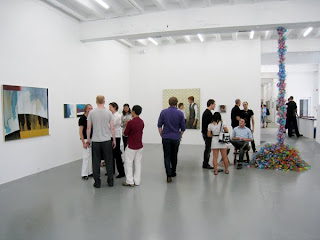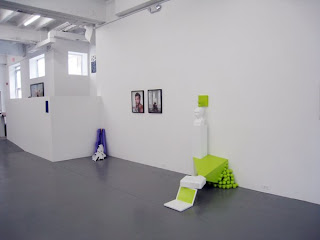 All photos by Rafael Soldi, a MICA graduate and participating artist in Academy 09
All photos by Rafael Soldi, a MICA graduate and participating artist in Academy 09Interview with Leigh Conner and Dr. Jamie Smith, Ph.D. on ACADEMY 2009 at Conner Contemporary, the gallery’s 9th annual invitational survey of outstanding work by recent fine art graduates of regional college art programs.
Participating artists: Celina Amaya, Danny Baskin, Alan Callander, Charles Clary, Margot Ellis, Kyle Ford, Jeremy Flick, Corey Grimsley, Steve Ioli, Casey Reed Johnson, Jin Young Kang, Patrick McDonough, Aziza Murray, Igor Pasternak, Ding Ren, Alex Roulette, Andrew Schrock, Ryan Schroeder and Rafael Soldi.
Represented institutions: American University, Catholic University of America, Corcoran College or Art and Design, Georgetown University, George Washington University, Maryland Institute College of Art, Savannah College of Art and Design, University of Maryland.
 Cara Ober: There are a handful of exhibitions in the Washington/Baltimore area which feature recent art school graduates, including Conner Contemporary, Irvine Contemporary, and Maryland Art Place, to name a few. These exhibits seem like a win-win situation for emerging artists, as well as gallery directors looking for fresh talent. Your ‘academy’ program is in it’s ninth season, several years ahead of all the other existing programs, making it appear to be the prototype for all the others. Why did you start your ‘Academy’ exhibition program nine years ago?
Cara Ober: There are a handful of exhibitions in the Washington/Baltimore area which feature recent art school graduates, including Conner Contemporary, Irvine Contemporary, and Maryland Art Place, to name a few. These exhibits seem like a win-win situation for emerging artists, as well as gallery directors looking for fresh talent. Your ‘academy’ program is in it’s ninth season, several years ahead of all the other existing programs, making it appear to be the prototype for all the others. Why did you start your ‘Academy’ exhibition program nine years ago?
Jamie: The driving motivation for Academy is to give exposure to exciting new work created by emerging artists and to recognize the strengths of academic art programs in the DC region. The art community here benefits greatly from this vital resource. From a gallery’s perspective, it’s important to actively show our support. I founded Academy in Conner Contemporary Art’s second year, a time when Leigh and I were formulating long-term objectives and developing a sustainable programme. We were researching the Washington Color movement, which was led by Morris Louis, Kenneth Noland, Howard Mehring and Thomas Downing. The legacy of these artists, who studied and/or taught at regional schools, has had a lasting impact on area academic programs.
One reason Conner Contemporary Art has remained in DC since opening ten years ago is that this city is a vibrant source of emerging of artistic talent, which, by virtue of its academic art institutions, is constantly renewing itself. Academy launched during a period when there was much buzz about the possibility of a new global art world consisting of an international network of galleries whose programmes would transcend regional identities. But, instead of trying to eradicate the idea of the local artist, which many viewed as provincial and out-dated, Leigh and I mobilized to promote artists here and to help make DC a viable place for them to show their work.
Cara: How has this exhibit affected young artists’ careers?
Jamie: Academy is intended to facilitate the entry of BFA or MFA grads into professional life. The show occurs at a critical, transitional stage of their careers, when they may begin to feel disenfranchised or discouraged. One impetus of the show is to encourage artists to keep making work and to demonstrate that there is an audience and an art community for them in DC. Conner Contemporary Art provides a venue for emerging artists to interact with one another, as well as established artists, collectors, curators, gallerists and others active in the art world. I can’t speak for the artists who have exhibited in Academy, but I do know that several of them have made strides in gaining gallery representation and exhibiting at international venues. Outstanding examples include Mary Coble, whose work is in the permanent collections of the Brooklyn Museum and the Hirshhorn, and Julee Holcombe whose work was featured in a recent exhibition at the British Museum.
Cara: How do you choose the artists for your Academy program? What are the criteria?
 Jamie: I don’t have a set checklist of qualifications. I make an effort to approach the thesis shows with a very open mind, because I really never know what I’m going to find. Discovery is a great motivation. Leigh and I enjoy going to the shows together, whenever possible, and I value her insights. My decisions are largely experience-based – it’s a sensory process of looking, perhaps listening, or interacting with the pieces, (sometimes even smelling them!) Being in the presence of the work is essential. Some works just stand out for various reasons – the artist’s command of the medium, the concepts that are evoked, or critical engagement of the work with art historical precedents – any or all of these factors may be involved.
Jamie: I don’t have a set checklist of qualifications. I make an effort to approach the thesis shows with a very open mind, because I really never know what I’m going to find. Discovery is a great motivation. Leigh and I enjoy going to the shows together, whenever possible, and I value her insights. My decisions are largely experience-based – it’s a sensory process of looking, perhaps listening, or interacting with the pieces, (sometimes even smelling them!) Being in the presence of the work is essential. Some works just stand out for various reasons – the artist’s command of the medium, the concepts that are evoked, or critical engagement of the work with art historical precedents – any or all of these factors may be involved.
As I visit each thesis show, I make a broad list of possible inclusions, then I have to make tough choices. I consider each Academy exhibition to comprise a current profile of the region’s art programs, which brings forth the strengths of each school. I also try to envision how the pieces will work in concert as a group show, in situ, where common themes, contrasts, and complementary aspects may emerge. Even as large as our gallery is, there is a limit to the number of works I can include. For every artist I invite to exhibit, I know there are several others who have also put forth good efforts, but will not be in the show. I’m glad that other galleries have stepped up in recent years to show student work. Whereas the selections for Academy reflect my own academic training, professional experience, and judgment, diverse curatorial perspectives can be invigorating for the art community.
Cara: Is there any type of mentoring or education that goes into this exhibition?
Jamie: Yes, one of the main benefits of a show like Academy is the experience gained by the artists involved. The exhibition is intended to help graduates progress from thinking about work in terms of academic requirements to presenting themselves as independent, professional artists. I think artists at this stage gain a lot from talking about their work to curators, gallerists, collectors and other artists during the run of the exhibition. Of course, there is sometimes an educational component, which may involve an explanation of the logistics of consignment agreements, edition sizes, transportation and installation of the works. As this is, for many grads, the first involvement with a gallery, we try to be as patient, informative, and encouraging as possible. Many artists have contacted Leigh or me after the exhibition for further advice about exhibition opportunities with other galleries, recommendation letters, references, introductions, or referrals. In this way, the artists let us know how they are growing as professionals, and we continue to reinforce their careers. Two years ago, we created *gogo art projects as a step beyond the Academy level, which allows emerging artists to gain more experience and exposure as they ready themselves to advance further professionally.
Cara: This year, the ‘Academy’ exhibit has taken the stakes a step higher: an award winning artist from the show is chosen by outside jurors to present their work at Pulse Miami 09, an international art fair. Rather than a cash award, the Pulse prize gives something much more valuable to a young artist: an international audience and an incredible learning experience. This opportunity is even more dramatic because of the economic woes hitting the art market, as many opportunities for exhibitions disappear. How did this award materialize?
Leigh: Helen Allen, the Executive Director of Pulse Art Fair, and I were talking last winter, and she was telling me about Pulse Presents, a new initiative to they developed to support art projects through out the year. I told her about our annual Academy show and she saw it as a great opportunity to support emerging art. The prize is a natural fit – CCA supports Academy (and *gogo art projects) and Pulse supports young galleries and their emerging artist through the Impulse section of their Fairs.
Cara: Why did you see this as an important step for the Academy show?
Leigh: The underlying goal of the annual Academy exhibition is to encourage promising young artists to remain working artists. With the Pulse prize, Academy is recognized on an international level as an important platform for young art in our region. The more recognition and encouragement these artists get, the better we can reach our goals.
 Cara: Will this become an annual opportunity or a one-time occurrence?
Cara: Will this become an annual opportunity or a one-time occurrence?
Leigh: I certainly hope that it becomes an annual opportunity (!).
Cara: Who were the jurors involved in choosing the Pulse prize and how were they selected?
Leigh: The jurors for the Pulse Presents price were – Helen Allen, Executive Director of PULSE, Ed Winkleman, Director of Winkleman Gallery, NYC and Gloria Nauden, Executive Director of the DC Commission on the Arts and Humanities. The jurors were selected by Helen Allen. I believe she chose well – each person brings a different area of interest and expertise to the process.
Cara: Having their work viewed by nationally known jurors also seems like a great benefit for all the artists participating in the exhibit.
Leigh: I agree. Not only was the work viewed by these jurors but also by many gallerists, collectors, curators as well as peers from other colleges. There was a collector at the opening that we met in Brussels, Belgium this spring as well as two gallery owners from New York, several from the DC area and quite a few curators — not to mention over 600 people through the door.
Cara: There were two artists chosen for the inaugural presentation this year instead of one. Who are they and how will this affect the way the prize will be awarded?
Leigh: The artists are Danny Baskin (Maryland Institute College of Art) And Andrew Schrock (Catholic University). I know that the jurors had a very difficult decision and their process lasted over 2 days. I am not sure how the awarded space will be allotted; however, Jamie and I are here to help advise the artists on the best ways to exhibit work at an art fair and how to take advantage of the opportunity.
Cara: Thanks for all that you are doing for young artists, with this exhibit and the award. I have to mention that one of my former MICA students, Danny Baskin, was one of the two selected and I am just thrilled about it.
Leigh and Jamie – Thanks for your interest in Academy, Cara. We, too, are thrilled for the strong showing by all of the artists and for the opportunities ahead of Danny and Andrew at Pulse Miami!



